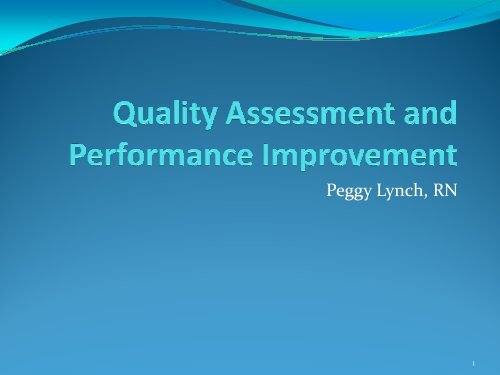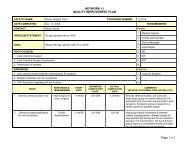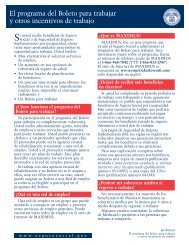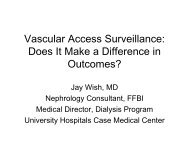QAPI PowerPoint presentation - ESRD Network of New England
QAPI PowerPoint presentation - ESRD Network of New England
QAPI PowerPoint presentation - ESRD Network of New England
You also want an ePaper? Increase the reach of your titles
YUMPU automatically turns print PDFs into web optimized ePapers that Google loves.
Peggy Lynch, RN1
What is QualityAssessment &PerformanceImprovement?• It is the team continually examining the overall care given in the dialysis clinic andalways seeking ways to improve• It is an ongoing evaluation <strong>of</strong> operatingsystems & clinical process rather thanindividual problems• It is data driven2
Is <strong>QAPI</strong> different than CQI?Not really:• Both are data driven• Both focus on continual improvement in patient’sclinical outcomes• Both help identify if patient safety issues• Both focus on reducing errors• Both encourages the dialysis i clinic i to evaluateoperating process & systems instead <strong>of</strong> fixing oneproblem at a time3
Effective <strong>QAPI</strong>Is an ongoing program that achieves……Measurable improvements in health outcomesExamples:1. Reduction in medication errors2. Reduction in patient falls3. Increase in AV Fistula Rates4. Increase in number <strong>of</strong> patients with hgb 11‐12g/dL5. Improvement in staff retention6. Rd Reduction in skipped or shortened treatments4
Why Data Driven?• If system processes & clinical outcomes are notroutinely examined, tracked & trended thenproblem areas may not be identified• Aggregate data measures performance bothclinically & operationally• Ongoing g data collection o will depict ifimprovements are sustained5
Establish Goals for CPMs• Adequacy• Nutrition• Bone Disease• Anemia• Vascular Access• Medical Errors• Reuse• Pt. Satisfaction• Infection Control• KT/V, URR• Albumin levels• PTH, CA+, PO4• HGB, Ferritin• Decrease Catheters• Decrease specific errors• < adverse outcomes• Increase survey scores• vaccinationsi6
Developing Your <strong>QAPI</strong>• Write a clear statement <strong>of</strong> the purpose <strong>of</strong> theimprovement• Include numeric goals• Focus on issues that are important to your dialysisclinic – prioritize, how it impacts patient care• Include an estimated time frame for goal attainment7
<strong>QAPI</strong> : Team• Interdisciplinary approach• Health care team is multi‐faceted• Each discipline part <strong>of</strong> processes• Each discipline impacts each other• Each team member contributes• Each team member is responsible8
Implementing a <strong>QAPI</strong>• Collected data may identify problem areas• The Medical Director & health care team utilizesroot cause analysis to identify possible solutions• Implementation <strong>of</strong> possible solutions• Data collected post solution implementation toexamine effectiveness <strong>of</strong> solution put in place• Continue data collection to see if improvement issustained9
<strong>QAPI</strong> : Evaluation• Evaluate processes <strong>of</strong> care• Are we doing what we want to do?• Are practice guidelines followed?• Do protocols need to be re‐evaluated?• Is staff & patient education effective?10
What is Quality?Quality is a never‐ending cycle<strong>of</strong> continuous improvement.-Deming11
12Quality Alphabet SoupQATQM PIPDSACQIPDCAIOPQIRCQI
Model for ImprovementThe Improvement Guide. Langley, Nolan et al. 13
What are we trying to accomplish?• An aim is a clear statement t t <strong>of</strong>:• Intended improvement• How it is to be measureded• What is the time frame• Use an aim statement t t to:• Stay focused• Communicate expectations• Define success14
Multiple tests <strong>of</strong> change orRapid idCycles achieve goalWhat arewe tryingto accomplishHow will we knowthat a change is animprovement?A PS DWhat changes canwe make that willresult in improvement?A PS DA PS DWhat changes canwe make that willresult in improvement?A PS DWhat changes canwe make that willresult in improvement?What changes canwe make that willresult in improvement?15
Following o the PDSA Roadmapap• Plan• Do• Study y( (Check)• ActACTSTUDYPLANDO16
ActPlanP‐D‐S‐A‐CYCLE• PLAN: 1. IDENTIFY THE PROBLEM2. ANALYZE THE PROBLEM• DO: 3. DEVELOP SOLUTIONS4. IMPLEMENT SOLUTIONSStudyDo• STUDY: 5. EVALUATE RESULTS (if goal achieved go to step 6 ,if not go back to step 1• ACT: 6. STANDARDIZE SOLUTIONS7. MONITOR FOR CONTINUED IMPROVEMENT17
Immediate Correction RequiredExamples <strong>of</strong> serious health & safety issues:• Unsafe water or dialysate• Defective clinical equipment• Unsafe reprocessing <strong>of</strong> dialyzers• Epidemiological risks• Insufficient number <strong>of</strong> competent staff toperform scheduled treatments18
Some Conceptual Tools To Use•PDSA/Rapid Cycle•Flow Chart Diagram•Cause & Effect Diagram•Root Cause Analysis19
PDSA/RAPID CYCLEASSESSMENTPrioritizationEvaluation/ReportingCath.DataInfectionreviewrate on theClinical Outcome rise? ImprovedBrainstorm for/repeat cause &cycle solutionsPlanningImplementation20
Flow Chart DiagramReview <strong>of</strong> ReuseprogramReusesnumbersevaluatedReuse numbersWNLNoReview & identifysteps in the reuseprocess.Interview staff aboutprocess stepsYesContinue wiithprogramDothe steps equalthe process?NoEvaluatedifferencesYesRepeat evaluation<strong>of</strong> reuse numbers.Ischangeneeded?NoReview the processagain to identify thevariance.YesCreate cause &effect diagram toidentify contributingvariablesContinue to C&Ediagram21
Cause & Effect Diagram (Fishbone)PatientReproStaffDocumentation - Pt - Machine - DialyzerVolume - Pressure - Visual FailsVisual Inspection <strong>of</strong> EquipmentComplianceVascular AccessTime Delay ReproPost Tx. RinseUniform TechniquesParticipation in ProcessQualityPatientHeparin DosingBlood Sampling MethodCarePriming ProcedureDialyzer Size & HandlingRinse Back ProcedureReprocessing <strong>of</strong> DialyzerBlood Flow RateTime <strong>of</strong> TreatmentDialyzerKinetics22
Root Cause AnalysisClinic AVF Rate < Desired GoalFacility AVF Goal= 65%Fear <strong>of</strong> needlesAVF notprimarychoiceSurgeon BarriersPatientBarriersAVF GoalNot MetFacilityBarriersNephrologistsBarriersLate referral to surgeonNo VA coordinator23
Conclusion• Quality Assessment and Performance Improvement isthe responsibility <strong>of</strong> all dialysis clinics andpractitioners• An ongoing <strong>QAPI</strong> can make a positive difference in thequality <strong>of</strong> care we give, we all strive to do better• Both patients and staff will benefit from an effective<strong>QAPI</strong> program• The <strong>QAPI</strong> will help formalize what all practitionerswant; to continually improve our outcomes24
QUESTIONS???25








